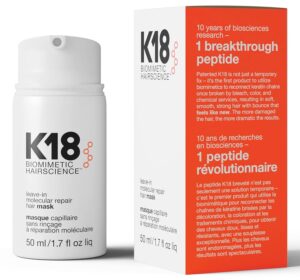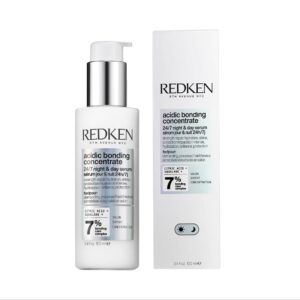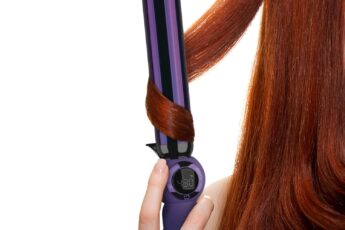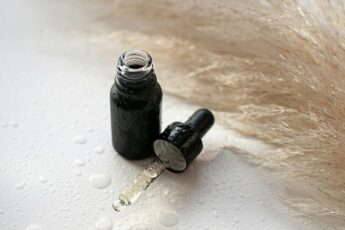Let’s be honest—hair talk gets overwhelming fast. One minute you’re trying to figure out if you need a deep conditioner or a mask, and the next, someone drops “bond multiplier” into the mix. Sounds kind of science-y, doesn’t it?
I remember the first time I heard about one. I stared at the bottle and thought, What are you even multiplying, and why does my hair need math?
But once I started using it—and once I understood what it was actually doing to my hair—I couldn’t go back. If your hair’s been through a lot lately (and I mean heat, bleach, or tight ponytails that pull like your life depends on it), then this hair bond multiplier guide is exactly what you need. I’m walking you through it all, no fluff, no confusion. Just you and me figuring out how to help your hair bounce back.
Table of Contents
What Is a Hair Bond Multiplier, Really?
So, here’s the simple version.
Your hair has these tiny connections inside it called “bonds.” They hold everything together. When your hair looks strong, smooth, and shiny? That’s because most of those bonds are intact. But things like bleach, flat irons, and even combing too hard can snap those bonds.
That’s where a bond multiplier comes in. It’s not just coating your hair or making it feel soft on the outside. It’s going inside your hair, finding the broken bits, and patching them up from the inside out.
It’s kind of like giving your hair scaffolding. You’re not just painting the walls. You’re rebuilding the structure.
And nope, this isn’t the same as a deep conditioner. A conditioner smooths the outer layer of your hair. A bond multiplier goes deeper. Think of it like your hair’s emergency support team.
Why You Might Need One (Even If You Think You Don’t)
Okay, maybe you haven’t bleached your hair platinum blonde or fried it with a curling iron this week. But let me ask you something:
- Does your hair break easily when you brush it?
- Does it feel rough no matter how much conditioner you use?
- Is it losing its bounce or shape?
If you nodded, even a little, your bonds might be begging for help.
Even the little stuff adds up. Things like tight buns, sleeping with your hair loose, or using the wrong shampoo can slowly wear down those internal connections. You might not notice it all at once, but over time, your strands lose their strength.
And honestly, you don’t need a hair disaster to justify using one. I started using a bond builder before I had major damage, and it’s probably why I avoided the breakage I was heading toward.
Also Read: Olaplex vs Smartbond: Which One Prevents Bleaching Damage?
How Hair Bond Multipliers Actually Work
Now, this is where it sounds complicated, but stay with me. I’ll keep it simple.
Inside every strand of hair, there are these disulfide bonds. They’re the main things keeping your hair strong. When you color your hair or apply heat, those bonds break.
A hair bond multiplier finds those broken bonds and reconnects them—or at least as many as it can. It doesn’t just patch things temporarily. It helps restore the actual structure, like repairing a torn ladder rung instead of just taping it.
What you get is stronger, more resilient hair—not just softer, shinier hair for a day or two.
I didn’t expect to feel the difference the first time. But I ran my fingers through my hair after rinsing, and it didn’t feel hollow or gummy anymore. That’s when I got it. This wasn’t surface-level stuff. This was real.
When Should You Use a Bond Multiplier?
There’s no single rule here. But I’ll tell you what’s worked for me.
I reach for mine right after coloring my hair, especially if I’ve gone lighter. Bleach is brutal. Using a bond builder immediately afterward can stop the damage from spreading.
I also use it weekly, kind of like a reset button. If I’ve used more heat tools than usual or noticed extra breakage on my brush, that’s my sign.
If your hair is already fragile, you might want to use it once a week at first. Over time, you can dial it back. Just pay attention to how your hair feels. If it’s getting stronger, less stretchy, and more elastic, it’s working.
Oh—and don’t expect instant miracles. It’s not a magic wand. It builds strength gradually, but that strength lasts.
How to Use It the Right Way (Step-by-Step)
This part gets tricky because different products have different instructions. But I’ll walk you through the general method I use.
Here’s what I do:
- Start with clean, damp hair.
I usually shampoo first with something gentle, then towel-dry so my hair’s not soaking wet. - Apply the bond multiplier from root to tip.
You don’t need to saturate your hair like you’re deep conditioning it. Just coat everything evenly. - Comb it through.
This helps spread the product and ensures every strand gets some love. - Let it sit.
Some formulas say 10 minutes, others say 30. I usually go with 20 unless the bottle says otherwise. - Rinse thoroughly.
Don’t leave residue behind—it won’t help you. - Follow up with conditioner if needed.
Some bond builders can make your hair feel a little stiff right after. Conditioner helps smooth things out.
That’s it. No heat cap, no special tools. Just quiet time for your hair to rebuild.
What to Expect After Using One
The first time I used one, I wasn’t sure what I was looking for. I didn’t expect my hair to suddenly glow or behave like I was in a shampoo commercial.
But here’s what happened:
- It stopped snapping when I brushed it.
- It held its shape better when I styled it.
And it just felt… solid again.
Not stiff, not weighed down. Just sturdy, like it could finally handle life again.
Some people say their hair feels a bit stiff after the first use, especially with formulas like Olaplex. That’s normal. It’s your hair adjusting to a stronger internal structure. It usually softens up after your next wash or conditioner.
You might not get glassy shine right away, but what you will get is the foundation for healthier hair. The surface stuff comes later. Trust me.
Check Out: The Truth About Cream-Based Hair Treatments (And How to Use Them Right)
Not All Bond Builders Are Created Equal
There are a lot of them out there now, and I’ve tried more than a few.
Here’s a quick breakdown of the ones I’ve tested:
Olaplex No. 3

- Probably the most famous one.
- Works well but can feel stiff if you overuse it.
- Best if you’ve got major chemical damage.
K18 Leave-In Mask

- Works on a deeper level—uses peptides.
- No rinse needed.
- Took a few uses before I saw a big difference, but when it kicked in? Wow.
Redken Acidic Bonding Concentrate

- Super hydrating.
- Ideal for dry and brittle strands.
- Smells nicer than some others too.
If your hair’s thick and coarse, you might prefer Redken. If it’s fine or color-treated, Olaplex or K18 might be better. But honestly? You won’t know until you try.
Mistakes to Avoid with Bond Multipliers
Let’s keep it real—these aren’t miracle serums. And if you’re not careful, you might not get the results you’re hoping for.
Here’s what I’ve learned the hard way:
- Don’t overuse them.
More isn’t better. Using one every day won’t speed up the healing. You’ll just waste product. - Don’t skip shampoo first.
If your hair’s covered in oil or product, the bond builder won’t sink in. - Don’t expect instant softness.
These aren’t meant to make your hair feel like silk right away. They’re doing the groundwork. - Don’t mix too many treatments.
If you’re using a protein treatment, bond builder, mask, and oil all in one day, your hair might rebel. Give it space to breathe.
Conclusion
If your hair’s been crying out for help—or even just whispering that it’s tired—bond multipliers are something worth exploring. They go beyond the surface. They fix what’s broken, one connection at a time.
You don’t need to be a chemist. You don’t need a hair crisis. All you need is curiosity and a little patience.
Your hair’s been through a lot. But it doesn’t have to stay damaged. With the right bond builder, you can give it a fresh start—without starting over.
Frequently Asked Questions
Can a bond multiplier repair hair permanently?
Not quite. It helps rebuild the bonds, but if you keep damaging your hair, they’ll break again. It’s more of a repair-and-maintain situation.
Do I need one if I don’t dye my hair?
Yes, if you heat-style often or have fragile strands. Even brushing too roughly can break bonds over time.
Can I use a bond builder and deep conditioner together?
Yes—just don’t use them at the same time unless the instructions say so. I usually use a bond builder first, rinse it out, then follow with conditioner.
How long does it take to see results?
Some people notice a difference after one use, especially with Olaplex or K18. But real strength takes a few weeks. Be patient—it’s worth it.



